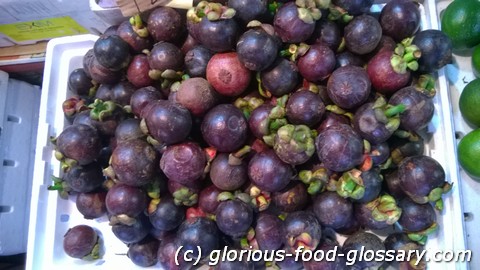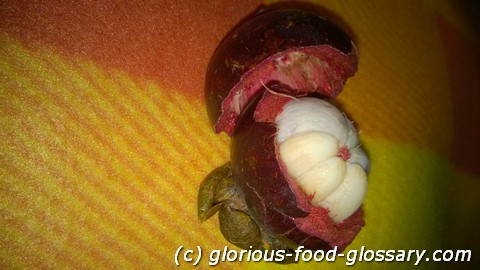Mangosteen (Garcinia mangostana), often hailed as the "queen of fruits," is a tropical fruit known for its unique taste and health benefits. The fruit has a thick, purple rind and a soft, white edible flesh inside, divided into segments. Mangosteen is celebrated not only for its delicate, slightly sweet and tangy flavor but also for its nutritional properties, including antioxidants, vitamins, and minerals.
Description
Mangosteen's flavor is difficult to compare directly with other fruits because it has a unique taste profile that combines sweet, sour, and floral notes. The fruit's edible part is the white flesh inside, which is juicy and fibrous, enveloping one or more seeds. The outer rind or pericarp is inedible in its raw state but is often used in traditional medicine and to make teas or extracts.
Application Areas
Mangosteen is enjoyed in various forms and settings, including:
- Fresh Consumption: The most common way to enjoy mangosteen is by eating the fresh fruit. The rind is typically cut or twisted open to reveal the white segments inside.
- Juices and Smoothies: Mangosteen is often used in juices and smoothies, either on its own or mixed with other fruits.
- Desserts: The fruit's segments can be incorporated into desserts, including fruit salads, sorbets, and tropical-themed pastries.
- Supplements and Teas: Extracts from the mangosteen rind are used in dietary supplements and teas, touted for their antioxidant properties.
Well-Known Examples
While mangosteen itself is a distinct fruit, it is part of the broader category of tropical fruits appreciated worldwide, such as:
- Lychee: Offers a sweet, floral taste and is also enjoyed fresh.
- Rambutan: Similar to lychee in flavor but with a hairy outer skin.
Recipes
Eating mangosteen is straightforward and usually involves consuming the fruit fresh:
- Preparation:
- Hold the mangosteen in your hands and press gently on the outer shell until it cracks, or use a knife to carefully cut around the equator of the fruit without piercing the flesh.
- Twist and lift the top half of the rind to expose the white segments.
- Remove the segments and enjoy, being mindful of any seeds within the flesh.
Treatment and Risks
Mangosteen is generally considered safe for consumption. However, as with any fruit, it's essential to wash the outer skin before opening it to avoid contaminating the edible flesh. People with latex or fruit allergies should exercise caution when trying new fruits, including mangosteen, for the first time.
Similar Terms or Synonyms
- Queen of Fruits
- Garcinia mangostana
Summary
Mangosteen is a tropical fruit prized for its unique taste and potential health benefits. It is consumed in various ways, from fresh fruit to juices and desserts, and is valued for its nutritional content and antioxidant properties.


Related Articles to the term 'Mangosteen' | |
| 'Salak' | ■■■■■■■■■ |
| Salak (Salacca zalacca) one of popular Thai fruit described as pear-shaped, with dark brown scaly skin . . . Read More | |
| 'Santol' | ■■■■■■■ |
| Santol (Sandoricum koetjape) refers to an apple sized fruit with juicy, translucent pulp that can have . . . Read More | |
| 'Hong' | ■■■■■■■ |
| Hong is a Vietnamese term meaning \'persimmon\'. . . . . . . Read More | |
| 'Huckle Berry Ice Cream' | ■■■■■■■ |
| Huckle Berry Ice Cream: Huckleberry Ice Cream in the food context refers to ice cream flavored with huckleberries, . . . Read More | |
| 'Muntingia' | ■■■■■■■ |
| Muntingia refers to a tree species known as , commonly called the Jamaican cherry, Panama berry, Singapore . . . Read More | |
| 'Vegetables' | ■■■■■■■ |
| Vegetables are edible plants or parts of plants that are consumed as part of a meal, primarily for their . . . Read More | |
| 'Passionfruit' | ■■■■■■■ |
| Passionfruit in the food context refers to the small, round fruit known for its vibrant flavour and aromatic . . . Read More | |
| 'Pulp' | ■■■■■■■ |
| Pulp in the food context refers to the soft, fibrous substance that remains after fruits or vegetables . . . Read More | |
| 'Beet greens' at fitness-and-health-glossary.com | ■■■■■■■ |
| Beet greens refer to the edible leaves of beetroot plants, which are often overlooked in favor of the . . . Read More | |
| 'Baking and Cooking' at fitness-and-health-glossary.com | ■■■■■■■ |
| The preparation of meals through Baking and Cooking plays a pivotal role in fitness, as it directly influences . . . Read More | |
